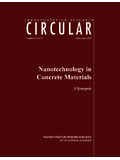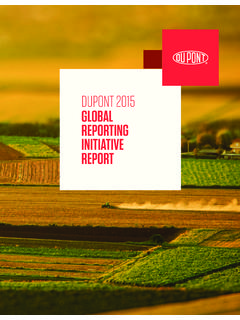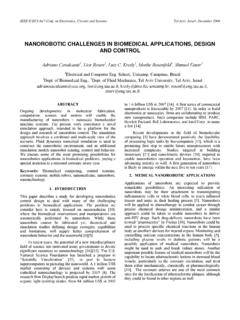Transcription of PAK. J. FOOD SCI., 22(1), 2012: 23-31 ISSN: 2226 …
1 PAK. J. food SCI., 22(1), 2012: 23-31 ISSN: 2226-5899 Pakistan Journal of food Sciences (2012), Volume 22, Issue 1, Page(s): 23-3123 Application of nanotechnology in food and dairy processing: AnoverviewQureshi, Mehar Afroz1; Karthikeyan, ; Punita ; Khan, Pervez Ahmed4; Uprit, Sudhir5; andMishra, Umesh Scholar, Dairy Technology, College of Dairy Technology, , Raipur, , India2 Assoc. Prof., Dairy Technology, College of Dairy Technology, , Raipur, , India3 Part time Lecturer, School of Studies in Computer Science and IT, Pt. , Raipur, , , School of Studies in Life Science, Pt.
2 , Raipur, , India5 Prof & Head (DT), College of Dairy Technology, , Raipur, , India6 Dean, College of Dairy Technology, , Raipur, , IndiaCorresponding the past few decades, the evaluation of a number of science disciplines and technologies have revolutionized food anddairy processing sector. Most notable among these are biotechnology, information technology etc. Recently nanotechnology , an essentially modern scientific field that is constantly evolving as a broad area of research, with respectto dairy and food processing, preservation, packaging and development of functional foods.
3 food and dairy manufacturers,agricultural producers, and consumers could gain a more competitive position through nanotechnology . Furthermore, thedelivery of bioactive compounds for nutritional as well as development of functional food are possible through thistechnology. nanotechnology will replace many fields with tremendous application potential in the area of dairy and foodsectors. Several critical challenges, including discovering of beneficial compounds, establishing optimal intake levels,developing adequate food delivering matrix and product formulation including the safety of the products need to beaddressed.
4 And also the potential negative effects of nanotechnology - based delivery systems on human health need to : nanotechnology , Nanocapsules, Nanolaminates, food and Dairy Processing, Nanotubes, Nanoceuticals,NanosensorsIntroductionIn today s competitive market new frontiertechnology is essential to keep leadership in the food andfood processing industry. Consumers demand fresh,authentic, convenient and flavourful food products. Thefuture belongs to new products and new processes, withthe goal of enhancing the performance of the product,prolonging the shelf life, freshness, improving the safetyand quality of food product.
5 nanotechnology has thepotential to revolutionize the food and dairy processingsectors days to is based on the prefix nano , aGreek word meaning dwarf . According to Pehanich(2006), nanotechnology is the understanding and controlof matter at dimensions of roughly 1 to 100 be more specific, nanotechnology is defined as thedesign, production and application of structures, devices,and systems through control of the size and shape of thematerial at the nanometer (10-9of a meter) scale whereuniquephenomenonenablenovelapplicat ions(Ravichandran,2006;NationalNanotechn ologyInitiative,2006).
6 Thistechnologyhasalreadyrevolutionized the health care, textile, informationtechnology, and energy sectors etc. and has been wellpublicized (Kumar and Rai, 2009). Several productsenabled by nanotechnology are already in the market,such as antibacterial dressings, transparent sunscreenlotions, light-diffracting cosmetics, penetration enhancedmoisturizers, stain and odour repellent fabrics, scratchfree paints for cars, and self cleaning windows, dirtrepellent coatings, long lasting paints and furniturevarnishes, and even some food products (Miller, 2008).
7 nanotechnology has been described as the newindustrial revolution and both developed and developingcountries are investing more in this technology. Recentlythe Helmuth Kaiser Consultancy predicted that thenanofood market will surge from billion USD to USD by 2010 and is extended to grow to $ in 2015. The government of India established theNanoscience and Technology Initiative in the later part ofthe 2001 through Department of Science and Technology(DST), New Delhi and invested about Rs. 350 Crores(2002-06) and granted approval for the Nanomissionworth Rs.
8 1000 crores for next five years (Patraet al.,2009). nanotechnology can be applied by two differentapproaches either bottom up or top down. in foodand dairy processing (Ravichandran, 2010). The top-down approach involves a physical processing of the foodmaterials, such as dry-milling of wheat into fine flour thatPAK. J. food SCI., 22(1), 2012: 23-31 ISSN: 2226-5899 Pakistan Journal of food Sciences (2012), Volume 22, Issue 1, Page(s): 23-3124has a high water-binding capacity. The antioxidantactivity in green tea powder is improved by when the sizeof the powder is reduced to 1000 nm, the digestion andabsorption resulted in an increase in the activity of anoxygen-eliminating enzyme (Shibata, 2002).
9 By contrast,self-assembly and self-organization are concepts derivedfrom biology that have inspired a bottom-up foodnanotechnology. For example, self-assembly structuresthrough organization of casein micelles or starch and thefolding of globular proteins and protein aggregates whichcreate stable entities to form nanometer scale via self-organization (Dickinson and Van Vliet , 2003).In food and dairy industries, the applications ofnanotechnologyincludeNanoparticulateDe liverySystems (nanodispersions and nanocapsules), Packaging(nanolaminates, nanocomposites bottles, bins with silvernanoparticles),FoodSafetyandBiosec urity(nanosensors)etc.
10 ( ).Thenanotechnology will play an vital role in the food anddairy processing in near future and would involve twoforms of nano food applications viz, food additives (nanoinside) and food packaging (nano outside). The nanoscalefood additives may be used to influence texture, flavour,nutritious improvement, provide functionally and evendetect pathogens and food packaging involves extendfood shelf life, edible, nano wrapper which will envelopefoods, preventing gas and moisture exchange, smart packaging (containing nano-sensors and anti-microbialactivators) for detecting food spoilage and releasingnano-anti-microbes to extend food shelf life (Richardsonand Piehowski, 2008; Miller, 2008).







